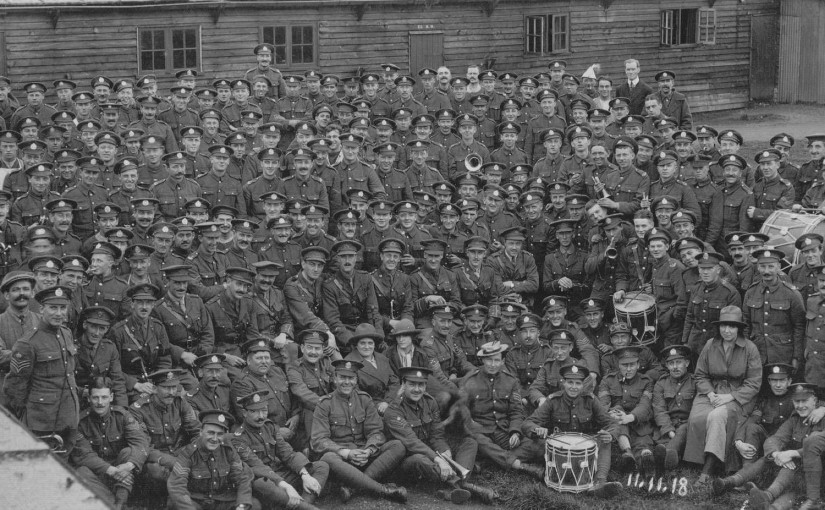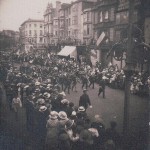By Tony May
With 2014 being the 100th anniversary of the beginning of The First World War and having recently watched the ‘The Great War’ boxed-set on DVD, I felt compelled to write something about civilized mans lowest moment in history.
How it is possible for one group of human beings to treat another in such a way, how individuals can be trained to run straight towards machine gun fire for King and country in the name of ‘freedom’ and how anyone involved was ever able to survive such unspeakable horror, or live with the memories should they have done so is quite beyond me…
World War 1 began on the 28th of July 1914 and lasted until 11 A.M. on the 11th of Nov 1918. Ridiculously (well, to me anyway), intense warfare continued right up to the last minute and tragically 2,738 men died on the very last day of the war…
The last French soldier killed was shot at 10.45 A.M. on his way to tell fellow soldiers that hot soup would be served after the ceasefire. The last British soldier, George Edwin Ellison of the 5th Royal Irish Lancers, was killed at 9.30 A.M while scouting on the outskirts of Mons, Belgium but it is perhaps the very last man killed, the American Henry N Gunther, whose death best advertises the sheer level of hate which had built up between the combatants. With just a minute to go before the Armistice, Henry charged astonished German troops and was shot.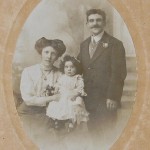
Am I right to blame Henry’s last charge on hate? It is amazing what passionate men will do for a cause they believe in and then of course there are orders to be followed. Military Generals never really think like ordinary human beings, do they? According to Wikkipedia the fighting continued right up to the last minute because artillery units did not want to have to haul away their spare ammunition and the Allies also wished to make sure that, should the fighting re-start, they would be in the best position. None of this makes any sense to me but then Page Fifteen does war ever really make sense or achieve anything? At the end of the day peace only ever comes from discussion and mutual agreement it is such a shame that as advanced a species as human beings are we still seem incapable of learning such a simple truth…
The exact amount of people who died in World War 1 will never be known but it is estimated that at least 16 million died as a result of the conflict and that another 20 million were injured. Ten million of those who died were military personnel two thirds of which died in battle. As for the rest they perished as a result of disease or were simply killed by accidents caused by the horrendous and treacherous conditions on the battlefield and in the trenches.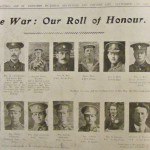
Great Britain mobilized a total of 5,397,000 men during World War 1 of which 703,000 were killed and 1,663,000 were injured. 1250 of the men killed were from the Hastings and St Leonards area and it would be lovely here for me to be able to tell you all a little about all of them but sadly that is just not possible. All I can do therefore to commemorate them is to tell you Maurice Rawlinson’s story (My Great Grandfather – Fathers side) and in so doing hope that it will inspire you at some point this year to spare a few moments to think of, remember and thank them all…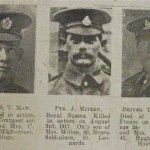
So what kind of place was Hastings before war began in 1914?
Well, for some time the adjacent towns had been enjoying a prosperous period. Ranked second only to Brighton in its appeal as a seaside resort visitor numbers to Hastings each summer were high. Hotels were making good money and many large Victorian Houses housed well-to-do people (and their servants) who were in the habit of staying on long into the winter months.
Places of entertainment were plentiful and The Gaiety Theatre in Queens Rd, The Palace of Varieties at Pelham Place and The Royal Concert Hall and Opera House in Warrior Square as well as our then TWO Piers provided music and entertainment to suit everyone – Hastings (& St Leonards) had a buzz about it, was considered a place to better ones health and was at the very peak of its powers…
In 1914 most major news stories broke first to the majority via newspapers. Reports & updates were longer and went in much more detail than today and so public opinion could easily be swayed by what was (or was not) printed. Newspaper sellers walked about the town selling latest additions and so it is quite likely that most of our townsfolk first found out about war being declared from such a source…
To begin with, life in Hastings continued almost as before. Hastings Corporation bought the shore end of Hastings Pier and set about widening it in order to build a new bandstand area and sand castle competitions (organized by the national newspapers) carried on as usual. Conscription (for men) into the Forces was not made compulsory until 1916 and so a number of ‘recruiting rallies’ took place. These were very grandiose affairs with military bands, parades and powerful, emotive speakers.
By September 1914, however, pressure upon young men to volunteer for military service was great and Lord Kitchener’s famous ‘Your country needs YOU’ posters were everywhere. Empty shops were taken over as recruiting offices and the band of the 5th Sussex Regiment marched the streets playing martial music. However strong ones personal objections to war were pressure from all angles was Page Sixteen on to ‘do your duty’ and sign up.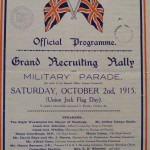
The Hastings & St Leonards Pictorial Advertiser began publishing photographs of Hastings people serving in the Forces under the banner of ‘Our Roll of Honour’. Looking through them at Hastings library is a very humbling experience indeed. While looking for my Great Grandfathers photo (unsuccessfully) I came across a number of men with the surname ‘May’ who fought. Not all of them came back either as a later edition of ‘Roll of Honour’ gave notice. To feel the harsh reality of the effect upon local families and to actually gaze at the faces of some who died for the cause is emotionally difficult to process but it is an education I feel that many of the lawless and unruly today could well benefit from…
Back to my Great Grandfather…
Thankfully, Maurice survived the war. Originally from Suffolk, Maurice was born in 1886 and moved to Hastings with his wife, Cymbeline a few years before the outbreak of war. Settling at no 3, St Mary’s Terrace up on the West Hill, ‘Mott’, as his friends knew him, quickly found work as an Upholsterer and Cabinet Maker (having served a three-year apprenticeship with (we think) ‘Mappin & Webb’ in London) and took on two apprentices of his own.
Sadly, I don’t know anything about the circumstances that led to Maurice joining the Forces. What I do know though is that the war soon made an impact on Maurice and my family.
In Oct 1914 news came through that Private (7052) Frank William Farrant, his wife’s brother, had been killed in action at Voilaines in France. Frank, a member of the 1st Battalion of the Cheshire Regiment had been lost on the second day of the regiments attempt to take La Bashee. With a second brother, Harry, already involved in the fighting to worry about, Cymbeline, a considerable distance from her relatives in Haverhill, Suffolk must have been beside herself with grief and worry.
Initially, many had believed that the war would be over in a matter of months. The euphoria, patriotism and positivity that had seen crowds line the streets to cheer our boys as they marched off to war was soon replaced for many families by the shuddering impact of the harsh reality…
As the supply of young men to join the cause diminished and with the focus now more firmly on the older generation to join up and help out, on the 11th of December 1915 Maurice enlisted and according to his medal card either joined or ended up in the Bedfordshire Regiment (No: 33284). Cymbeline was understandably deeply upset and frightened about the prospect of her beloved husband going off to war. I say beloved because she and ‘Mott’ had been childhood sweethearts long before they had married and so theirs truly was a love story. To make matters worse Maurice often suffered with severe bouts of Bronchitis in wet weather and Cymbeline feared life in the trenches might kill her husband let alone the Hun.
Quite the order in which events unfolded from there is unclear but what is certain is that on the 28th of Oct 1917 Cymbeline lost her second brother, Harry Farrant, to the conflict. A Gunner (174375) in the 26th Heavy Battery, Royal Garrison Artillery, like Frank, Harry was killed in action. For poor Cymbeline there was yet even more misery and heartache to come…Maurice is wounded in action.
Now, my Nan (Maurice’s Daughter), who is the source of most of this information, has always believed that her father received his war injuries during the Battle of The Somme. Trying to find more information on just when and where he may have done so online, however, proved that Nan must be wrong about this.
The reason I say this is that Maurice was mustard gassed and according to various online sources the Germans first used that particular weapon in September 1917. The Battle of the Somme took place between 1 July and 18th Nov 1916 and so it is far more likely that my Great Grandfather was actually gassed during one of the battles at Ypres towards the end of 1917.
This means that there is a good chance that poor Cymbeline not only had to deal with the effects of bringing up a young family alone but had to try somehow to deal with the grief of losing two of her brothers AND come to terms with the horrifying nature of her beloved husbands injuries.
Maurice was brought home for treatment at Glasgow Hospital. During the First World War, it was Army policy to treat injured men in hospitals long distances from their homes in order to try and dissuade family visits but Cymbaline was determined to see her man and so made the long journey from Hastings to Glasgow by night on the train.
Nan recalls needing to go to the toilet during the train journey and how she had to step carefully over the many Belgian soldiers that were crammed into the gangways of the packed train. In Glasgow hospital, they found ‘Mott’ in a ward containing eighty-four beds in a hammock (or something similar) and smothered in talcum powder. Injured from the waist down, for a long while any new skin to grow over the injured areas had to be peeled away in order to prevent Gangrene setting in. Maurice was blind for about a week and a lot of his (previously beautiful) set of teeth also rotted away.
How it must feel to see the man you love in such a sorry state and in such agonizing pain one can only imagine. According to Wikkipedia, there were over 164,000 British casualties of Mustard gas between July 1917 and November 1918 of which 4,086 died.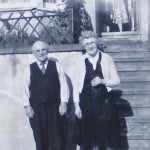
One nurse, Vera Brittain, wrote the following about her experience of treating those affected by Mustard Gas in her Page Seventeen 1933 autobiography, ‘A Testament of Youth’…
Sometimes in the middle of the night we have to turn people out of bed and make them sleep on the floor to make room for the more seriously ill ones who have come down from the line. We have heaps of gassed cases at present : there are 10 in this ward alone. I wish those people who write so glibly about this being a holy war, and the orators who talk so much about going on no matter how long the war lasts and what it may mean, could see a case – to say nothing of 10 cases of mustard gas in its early stages – could see the poor things all burnt and blistered all over with great suppurating blisters, with blind eyes – sometimes temporally, some times permanently – all sticky and stuck together, and always fighting for breath, their voices a whisper, saying their throats are closing and they know they are going to choke.
The strain is very, very great. The enemy is within shelling distance – refugee sisters crowding in with nerves all awry – bright moonlight, and aeroplanes carrying machine guns – ambulance trains jolting into the siding, all day, all night – gassed men on stretchers clawing the air – dying men reeking with mud and foul green stained bandages, shrieking and writhing in a grotesque travesty of manhood – dead men with fixed empty eyes and shiny yellow faces.
Thankfully, by the time Maurice was well along the road to recovery the war had ended. After the war ‘Mott’ returned to his job (which had been held open for him) at Bryant & Sons in Queen’s Road and he lived out the rest of his life here in Hastings.
Sadly, Maurice died on the 21st of Sept 1964 so I never got the chance to meet him. He was by all accounts a naturally fiery man but also one with a fabulous sense of humour. I share his love of Christmas and of only doing a job if you intend to do it properly and my Dad suffers with Bronchitis every time a cold gets into him so I understand that about him as a man at least. It is a rather sobering thought, however, that many people of similar age to me never even got the chance to hear about the later life of their Great Grandfather thanks to Kaiser Wilhelm II and Hastings has at least 1250 examples of that…
A little more about Hastings during the First World War years…
During the hostilities a great many soldiers en-route to France were temporarily billeted in Hastings. Hotels that would otherwise be empty during the winter season were often glad to put them up and received a small amount for doing so. As the war dragged on and injured men came home from the front many used the town to recuperate and the new widened Parade Extension served as the ideal place for wounded soldiers allowed out of hospital. Ironically, the Pier fire of 1917 (and a second blaze at The Electric Theatre Cinema in Wellington Place) was attributed to the soldiers carelessness with cigarette ends. With their special suits of blue and white flannel the soldiers must have been quite a reminder to all in the town of loved ones at the front….
Hastings traditional fishing fleet also found life difficult during the war years as mines were laid all along the coast severely restricting their usual activities. The beaches remained open to all but heavily shuttered machine gun nests were set up at intervals along the promenade. The anniversary of the breakout of war was marked each year with a special concert and the last of these took place in 1918 on St Leonards Pier. A similar event took place in January 1919 in order to welcome home local men.
The military pictures that accompany this piece come from the collection of Hastings Town’s dearly departed friend, Ewart White on Flickr. Ewart was a kind and generous man and he gave me written permission to ‘use what you like’ following an article I wrote about him and his collection a few years back.
Though the people of Hastings came out in large numbers to witness the military parade on Peace Day in July 1919 the atmosphere right across the country was more one of remembrance than of celebration. Every single person in the country had either lost someone dear or known someone who had and some, like Cymbeline, had lost more than one. To thus ‘celebrate’ a military victory did not seem appropriate to many and a number of ex-servicemen even refused to take part. If you look closely again at Ewart’s picture you can see for yourself that this was the case as in spite of the number of people lining the streets not one hat can be seen in the air, not one banner is raised… In contrast, take a look at the relief and happiness on the faces of those soldiers in the barracks picture (taken on Armistice Day) – for them at the time just to know it was finally over must have meant so much…
GOD BLESS THEM ALL!
P.S.) While I did a fair amount of research myself in order to produce this article I would like to acknowledge the work of Barry Funnell who so kindly left a copy of his ‘Hastings In The Two World Wars’ Lecture manuscript to Hastings Library. Reading Barry’s personal memories of 1914 really brought the period to life for me and I hope in writing the above I have done the same for you and thus done Barrys memory proud…
